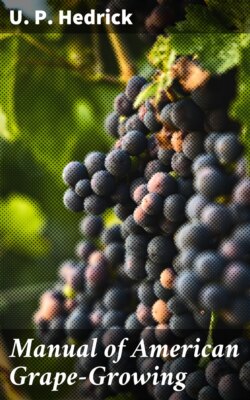Читать книгу Manual of American Grape-Growing - U. P. Hedrick - Страница 10
На сайте Литреса книга снята с продажи.
The Labrusca or fox-grapes.
ОглавлениеOf the several species of American grapes now under cultivation, the Labrusca, first represented by the Alexander, has furnished more cultivated varieties than all the other American species together, no less than five hundred of its varieties having been grown in the vineyards of the country. There are several reasons why it is the most generally cultivated species. It is native to the parts of the United States in which agriculture soonest advanced to a state where fruits were desired. In the wild, the Labruscas are the most attractive, being largest and handsomest in color; among all grapes it alone shows black-, white- and red-fruited forms on wild vines. There is a northern and a southern form of the species, and its varieties are, therefore, widely adapted to climates and to soils. The flavor of the fruits of this species, all things considered, is rather better than that of any other of our wild grapes, though the skins in most of its varieties have a peculiar aroma, somewhat pronounced in the well-known Concord, Niagara and Worden, which is disagreeable to tastes accustomed to the pure flavors of the European grapes. All Labruscas submit well to vineyard operations and are vigorous, hardy and productive, though they are more subject to the dreaded phylloxera than are most of the other cultivated native species. Of the many grapes of this type, at least two deserve brief historical mention.
Catawba, probably a pure-bred Labrusca, the first American grape of commercial importance, is the most interesting variety of its species. The origin of the variety is not certainly known, but all evidence points to its having been found about the year 1800 on the banks of the Catawba River, North Carolina. It was introduced into general cultivation by Major John Adlum, soldier of the Revolution, judge, surveyor and author of the first American book on grapes. Adlum maintained an experimental vineyard in the District of Columbia, whence in 1823 he began the distribution of the Catawba. At that time the center of American grape culture was about Cincinnati, and an early shipment of Adlum's Catawbas went to Nicholas Longworth of that city and was by him distributed throughout the grape-growing centers of the country. As one of the first to test new varieties of American grapes, to grow them largely and to make wine commercially from them, Nicholas Longworth is known as the "father of American grape culture."
Catawba is still one of the four leading varieties in the vineyards of eastern America. The characters whereby its high place is maintained among grapes are: Great elasticity of constitution, by reason of which the vine is adapted to many environments; rich flavor, long-keeping quality, and handsome appearance of fruit, qualities which make it a very good dessert grape; high sugar-content and a rich flavor of juice, so that from its fruit is made a very good wine and a very good grape-juice; and vigor, hardiness and productiveness of vine. The characters of Catawba are readily transmissible, and it has many pure-bred or hybrid offspring which more or less resemble it.
The second commercial grape of importance in American viticulture is Concord, which came from the seed of a wild grape planted in the fall of 1843 by Ephraim W. Bull, Concord, Massachusetts. The new variety was disseminated in the spring of 1854, and from the time of its introduction the spread of its culture was phenomenal. By 1860 it was the leading grape in America and it so remains. Concord furnishes, with the varieties that have sprung from it, seventy-five per cent of the grapes grown in eastern America. The characters which distinguish the vine are: Adaptability to various soils, fruitfulness, hardiness and resistance to diseases and insects. The fruits are distinguished by certainty of maturity, attractive appearance, good but not high flavor, and by the fact that they may be produced so cheaply that no other grape can compete with this variety in the markets. Concord is, as Horace Greeley well denominated it in awarding the Greeley prize for the best American grape, "the grape for the millions."
The histories of these two grapes are typical of those of five hundred or more other Labruscas. Out of a prodigious number of native seedlings, an occasional one is found greatly to excel its fellows and is brought under cultivation.
